Accepted Scientific Name: Thelocactus hexaedrophorus subs. lloydii (Britton & Rose) N.P.Taylor
Cactaceae Consensus Init. 5: 14. 1998
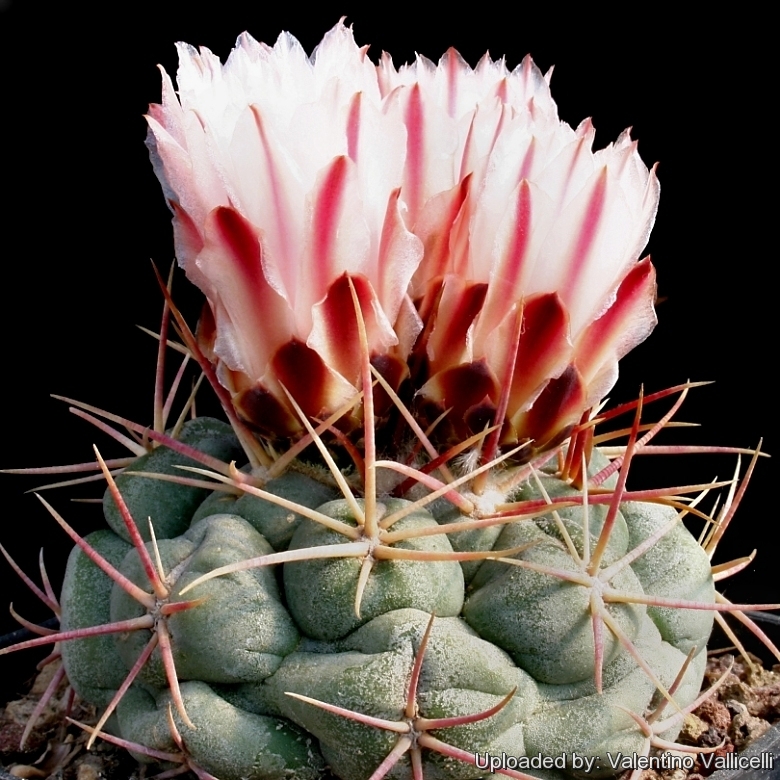
Thelocactus lloydii (Thelocactus hexaedrophorus subs. lloydii) Photo by: Valentino Vallicelli
SB113 Salinas, SLP, Mexico. This species has thick grey stems with fat flat tubercles which have polygonal bases to fit together without chins.
Synonyms:
See all synonyms of Thelocactus hexaedrophorus
Description: Thelocactus hexaedrophorusSN|10830]]SN|10830]] subs. lloydii is one of the old controversial geographical or morphological forms of the variable Thelocactus hexaedrophorusSN|10830]]SN|10830]] that distinguishes from the standard species for the delta-shaped tubercles, the more numerous (up to 3) reddish central spines, more numerous (6-8) reddish white to brownish radials, and smaller flowers 3,3-3,6 cm in diameter. However it look very similar to other varieties of Thelocactus hexaedrophorusSN|10830]]SN|10830]] which are linked one to each others by populations of plants with intermediate characteristics. Due to the species variability it seems not justified to recognise this subspecies. Nowadays all this forms are thought to belong to a unique polymorphic species.
Habit: Solitary and strongly armed cactus. Rarely clustering after many years, from the base.
Stem: Depressed-globose, 8 to 12 cm broad, grey to bluish-green, covered by a glaucous/grey pruina.
Tubercles: Thick but low, often wider than long, sometimes 4 cm. wide; flowering groove rather conspicuous but narrow, extending from spines to about half-way to axil of tubercle;
Spines: It has 1-3 reddish-white-brown central spines with sharp yellowish-crimson tips, the longer ones up to 6 cm, and 6-8 reddish-white brown radial spines per areole. Ascending from and curved outward from middle, terete and somewhat angled at base. The spines are often highly coloured and maintain that bright tint on at least part of the spines for a long time but bleach out to a pale grey-brown as they became older.
Flowers: Light pink to almost white with a darker midline, never deep purplish pink. Filaments whitish, anthers honey/yellow, style yellowish, (eventually pinkish at top), stigma lobes pinkish/yellowish.
Subspecies, varieties, forms and cultivars of plants belonging to the Thelocactus exaedrophorus group
 Thelocactus hexaedrophorus (Lem.) Britton & Rose: (subsp. hexaedrophorus) has hemispheric tubercles, 0-1 reddish central spine, 4-6 reddish radials, and flowers 4-5.5 cm Ø. Distribution: widespread in San Luis Potosi, Tamaulipas, and Nuevo Leon.
Thelocactus hexaedrophorus (Lem.) Britton & Rose: (subsp. hexaedrophorus) has hemispheric tubercles, 0-1 reddish central spine, 4-6 reddish radials, and flowers 4-5.5 cm Ø. Distribution: widespread in San Luis Potosi, Tamaulipas, and Nuevo Leon. Thelocactus hexaedrophorus var. droegeanus (Hildm. ex K.Schum.) Pilbeam: has ash-grey compressed, closely packaged tubercles, shorter spines and small flowers. Distribution: La Bonita, south of Matehulla in San Luis Potosi.
Thelocactus hexaedrophorus var. droegeanus (Hildm. ex K.Schum.) Pilbeam: has ash-grey compressed, closely packaged tubercles, shorter spines and small flowers. Distribution: La Bonita, south of Matehulla in San Luis Potosi. Thelocactus hexaedrophorus var. fossulatus (Scheidw.) Backeb.: Usually solitary, clustering only after many years, from the base It has 1 red central spine and 4-6 reddish-gray-white radial spines per areole They are thick, long and sharp.
Thelocactus hexaedrophorus var. fossulatus (Scheidw.) Backeb.: Usually solitary, clustering only after many years, from the base It has 1 red central spine and 4-6 reddish-gray-white radial spines per areole They are thick, long and sharp. Thelocactus hexaedrophorus var. fossulatus cv. Long spines (Japan) (Scheidw.) Backeb.: Selected cultivar immediately distinguished from the other Thelocacti of this grou for the very strong, long and colourful spines.
Thelocactus hexaedrophorus var. fossulatus cv. Long spines (Japan) (Scheidw.) Backeb.: Selected cultivar immediately distinguished from the other Thelocacti of this grou for the very strong, long and colourful spines. Thelocactus hexaedrophorus subs. kvetae Chvastek & Halda: has flattened discoidal bodies, bright purple-pink coloured flowers and larger seeds. Distribution: Central Mexico, San Luis Potosi [near Rio Verde].
Thelocactus hexaedrophorus subs. kvetae Chvastek & Halda: has flattened discoidal bodies, bright purple-pink coloured flowers and larger seeds. Distribution: Central Mexico, San Luis Potosi [near Rio Verde]. Thelocactus hexaedrophorus var. labouretianus (K.Schum.) Pilbeam: grey stems, white pink flowers, and nice spination. At first the plants have larger tubercles that may become closely packaged as the plant gets older.
Thelocactus hexaedrophorus var. labouretianus (K.Schum.) Pilbeam: grey stems, white pink flowers, and nice spination. At first the plants have larger tubercles that may become closely packaged as the plant gets older. Thelocactus hexaedrophorus subs. lloydii (Britton & Rose) N.P.Taylor: has delta-shaped tubercles, 1-3 reddish central spines, 6-8 reddish white to brownish radials, and flowers 3,3-3,6 cm Ø. Distribution: Zacatecas.
Thelocactus hexaedrophorus subs. lloydii (Britton & Rose) N.P.Taylor: has delta-shaped tubercles, 1-3 reddish central spines, 6-8 reddish white to brownish radials, and flowers 3,3-3,6 cm Ø. Distribution: Zacatecas. Thelocactus hexaedrophorus subs. lloydii f. major: has very long ( up to 8 cm long) central spines, more numerous (6-8) radials, and pure white flower. Distribution: San Luis Potosí and Nuevo Leon.
Thelocactus hexaedrophorus subs. lloydii f. major: has very long ( up to 8 cm long) central spines, more numerous (6-8) radials, and pure white flower. Distribution: San Luis Potosí and Nuevo Leon. Thelocactus hexaedrophorus subs. lloydii cv. monstruosus: has firm, rubbery-textured glaucous green stems, the surface is naked or with few scattered spine clustes.
Thelocactus hexaedrophorus subs. lloydii cv. monstruosus: has firm, rubbery-textured glaucous green stems, the surface is naked or with few scattered spine clustes. Thelocactus hexaedrophorus var. paradensis Pilbeam: It is a white flowering form of Thelocactus hexaedrophorus subs. lloydii. It is known in cultivation only.
Thelocactus hexaedrophorus var. paradensis Pilbeam: It is a white flowering form of Thelocactus hexaedrophorus subs. lloydii. It is known in cultivation only.
Bibliography: Majoer references and further lectures
1) N. L. Britton, J. N. Rose “The Cactaceae. Descriptions and Illustrations of Plants of the Cactus Family.” Volume 4, The Carnegie Institution of Washington, Washington 1923
2) Edward Anderson “The Cactus family” Timber Press, Incorporated, 2001
3) James Cullen, Sabina G. Knees, H. Suzanne Cubey "The European Garden Flora Flowering Plants: A Manual for the Identification of Plants Cultivated in Europe, Both Out-of-Doors and Under Glass" Cambridge University Press, 11/Aug/2011
4) David R Hunt; Nigel P Taylor; Graham Charles; International Cactaceae Systematics Group. "The New Cactus Lexicon" dh books, 2006
5) Clive Innes, Charles Glass “Cacti” Portland House, 01/May/1991
6) Hisho Hirao “Colour Encyclopaedia of Cacti” Seibundo Shinkosha Pub. Co., Ltd 1976
7) E Haustein “Der Kosmos Kakteenfuehrer” Balogh Scientific Books, United States, 01/Dec/1998
8) Willy Cullmann, Erich Götz (Dozent Dr.), Gerhard Gröner “The encyclopedia of cacti” Timber Press, 1987
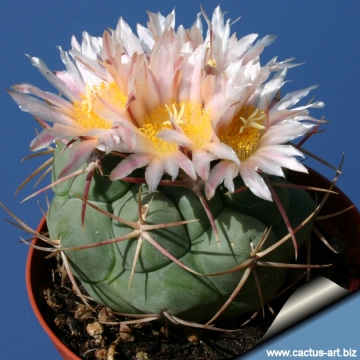 Thelocactus lloydii (Thelocactus hexaedrophorus subs. lloydii) Photo by: Cactus Art
Thelocactus lloydii (Thelocactus hexaedrophorus subs. lloydii) Photo by: Cactus Art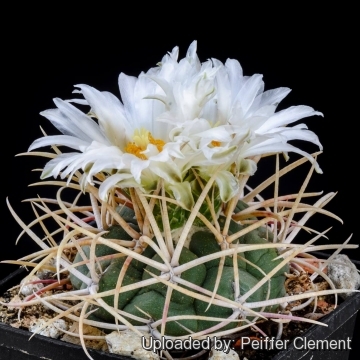 Thelocactus lloydii (Thelocactus hexaedrophorus subs. lloydii) Photo by: Peiffer Clement
Thelocactus lloydii (Thelocactus hexaedrophorus subs. lloydii) Photo by: Peiffer Clement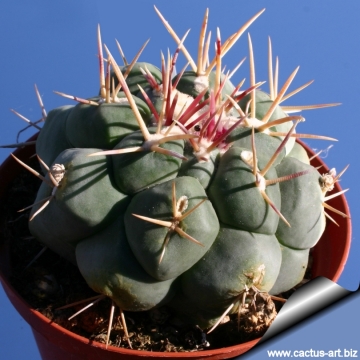 Thelocactus lloydii (Thelocactus hexaedrophorus subs. lloydii) Photo by: Cactus Art
Thelocactus lloydii (Thelocactus hexaedrophorus subs. lloydii) Photo by: Cactus Art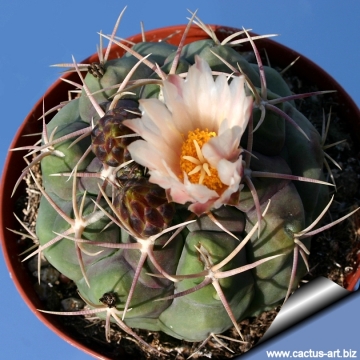 Thelocactus lloydii (Thelocactus hexaedrophorus subs. lloydii) Photo by: Cactus Art
Thelocactus lloydii (Thelocactus hexaedrophorus subs. lloydii) Photo by: Cactus Art Thelocactus lloydii (Thelocactus hexaedrophorus subs. lloydii) Photo by: Cactus Art
Thelocactus lloydii (Thelocactus hexaedrophorus subs. lloydii) Photo by: Cactus Art Thelocactus lloydii (Thelocactus hexaedrophorus subs. lloydii) Photo by: Valentino Vallicelli
Thelocactus lloydii (Thelocactus hexaedrophorus subs. lloydii) Photo by: Valentino Vallicelli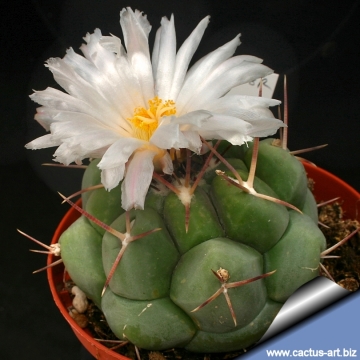 Thelocactus lloydii (Thelocactus hexaedrophorus subs. lloydii) Photo by: Cactus Art
Thelocactus lloydii (Thelocactus hexaedrophorus subs. lloydii) Photo by: Cactus Art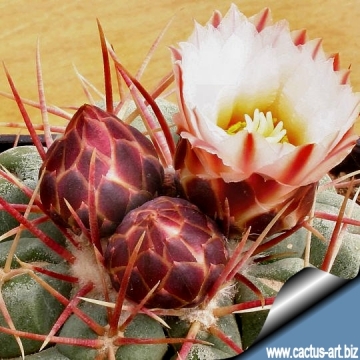 Thelocactus lloydii (Thelocactus hexaedrophorus subs. lloydii) Photo by: Cactus Art
Thelocactus lloydii (Thelocactus hexaedrophorus subs. lloydii) Photo by: Cactus ArtCultivation and Propagation: Thelocactus hexaedrophorusSN|10830]]SN|10830]] subs. lloydii is easy to cultivate and recommended for any collection that needs lots of light with ample airflow.
Growth rate: It is a small growing, but easily flowering species. It offset from the base and can fill a 25 cm pot in just a few years given the best conditions.
Soils: It likes very porous standard cactus mix soil with little organic matter (peat, humus).
Repotting: Repotting every 2-3 years. It will need a pot with sufficient depth to allow the tap root. As it is especially prone to rot under-pot in a smaller container filled with very porous compost. Use pot with good drainage.
Watering: Water regularly in summer, but do not overwater (very wet-sensitively, especially in light of its succulent root system). Its roots are easily lost in pots that stay damp for any length of time. Keep dry with ample airflow in winter. In the rest period no high atmospheric humidity!! Care must be taken with watering as they tends to become swollen and untidy in growth habit if given too much water and shade.
Fertilization: During the growing season enrich the soil using a fertilizer rich in potassium and phosphorous, but poor in nitrogen, because this chemical element doesn’t help the development of succulent plants, making them too soft and full of water.
Hardiness: Reputedly sensitive to frost , but less so if kept on the dry side prior to, and during, cold weather (hardy to -7° C for short periods). However some warmth throughout the year will increase the grower's success (minimum 5° to 8°C during rest season).
Exposition: Outside bright sun, filtered sunlight or afternoon shade, inside it needs bright light, and some direct sun. Subject to sunburn if exposed to direct sun for too long. Tends to bronze in strong light, which encourages flowering and heavy wool and spine production.
Uses: It is an excellent plant for container growing. It always looks good and stays small. It look fine in a cold greenhouse and frame.
Pests & diseases: It may be attractive to a variety of insects, but plants in good condition should be nearly pest-free, particularly if they are grown in a mineral potting-mix, with good exposure and ventilation. Nonetheless, there are several pests to watch for:
- Red spiders: Sensitive to red spider mite. Overhead watering is helpful in controlling mites.
- Mealy bugs: Occasionally mealy bugs they develop aerial into the new growth among the wool with disfiguring results, but the worst types develop underground on the roots and are invisible except by their effects.
- Scales: Scales are rarely a problem.
- Rot: Rot it is only a minor problem with cacti if the plants are watered and “aired” correctly. If they are not, fungicides won't help all that much.
Reproduction: Nearly always from seed, since the plant rarely produces plantlets.
Your Photos
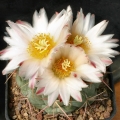
by Valentino Vallicelli



















